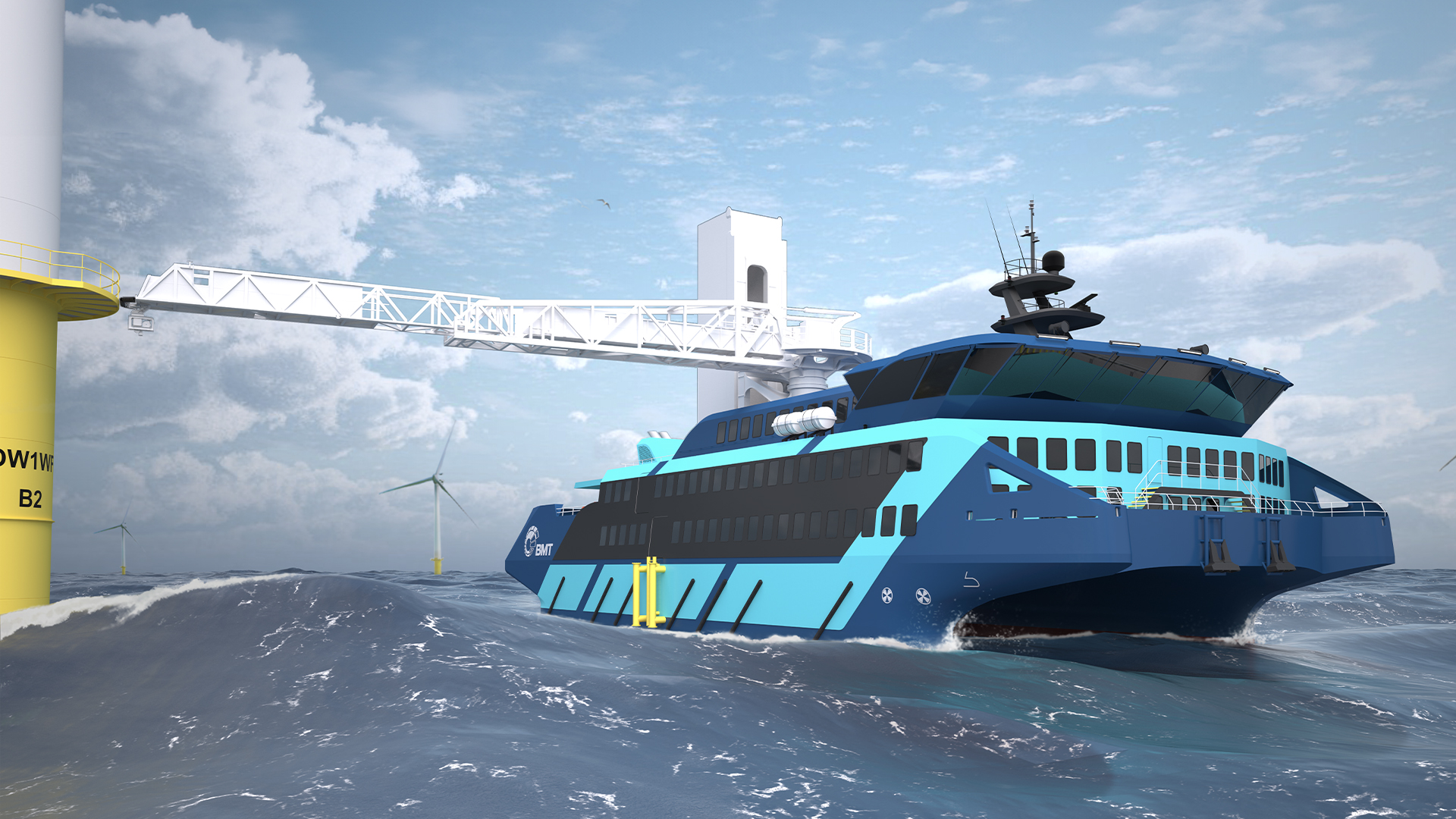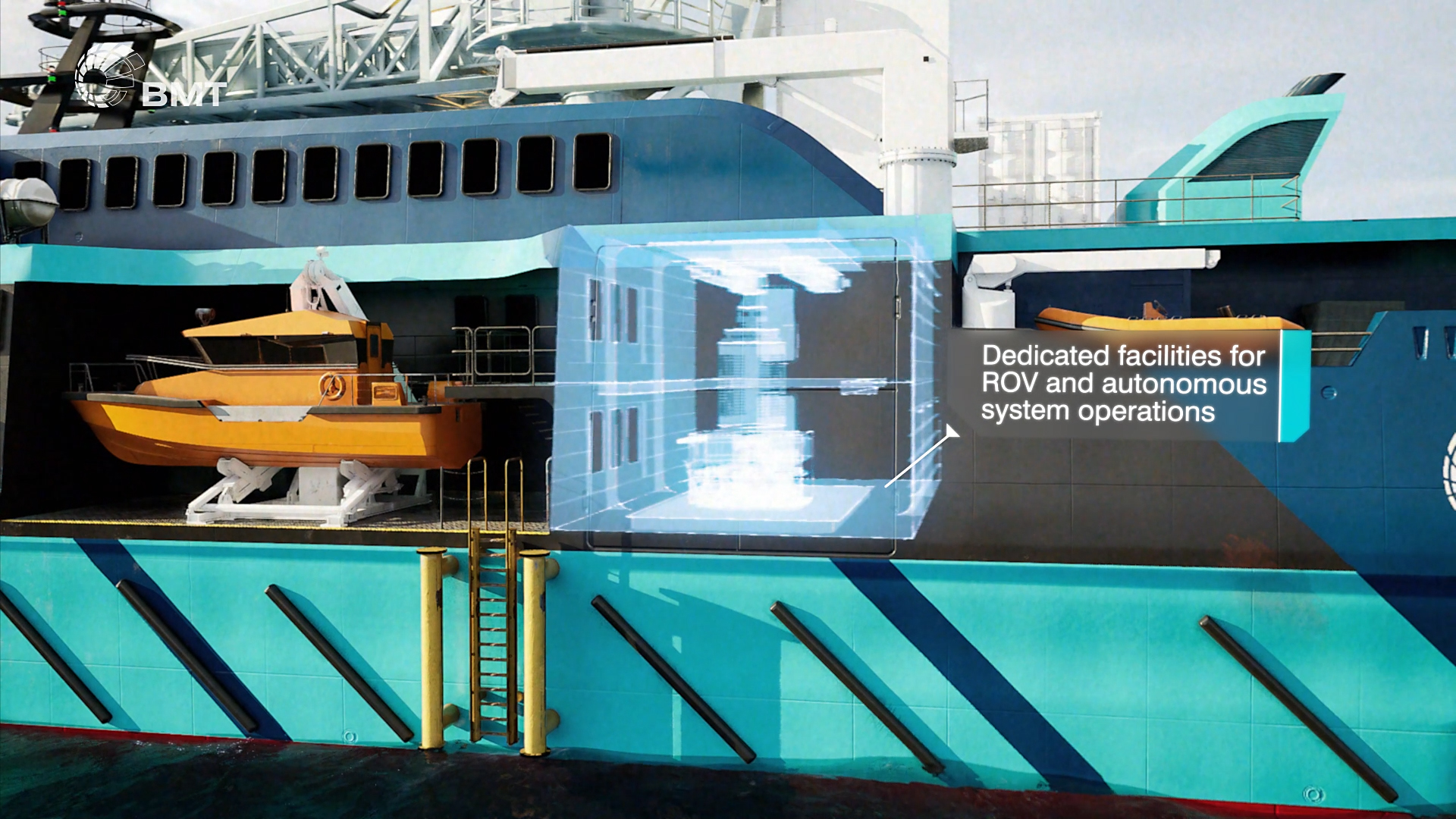
Offshore Support - downsizing for efficiency gains
Noel Tomlinson shares with SBI valuable insights on BMT's innovative solution to help vessel operators overcome challenges and ensure a sustainable future for offshore wind operations.
9 July 2024
This article was first published in the May/June 2024 issue of RINA Ship and Boat International (SBI) by Martin Conway, editor of SBI, and is reproduced here by kind permission of SBI. Article also available for download.
While the global offshore wind market continues to thrive, support vessel operators are still feeling the pressure when it comes to reducing overall Opex while cleaning up their act in terms of emissions control and reduced fuel consumption.
One proposed solution has been the creation of a ‘halfway house’ between traditional crew transfer vessels (CTVs), which carry the turbine technicians from shore to offshore site and back, and service operation vessels (SOVs), which typically remain on station at the site, acting as offshore motherships for long-term technician deployment. As reported in Ship & Boat International January/February 2024 (page 28): “While SOVs are useful in eliminating daily return trips between site and shore, they require a substantial investment…this high rate of Capex could see the energy majors try to pass the increased costs on to the consumer, but there is no guarantee that they will be willing to pay for this.”
This has prompted naval architect and designer BMT to develop the concept for a mid-sized, 48m-long vessel, sitting somewhere between a CTV and an SOV as a cost-effective, safe, comfortable and operationally efficient ‘best of both worlds’. The company’s proposed 48m SOV has been modelled on a diesel-electric platform and an optimised hullform, but also incorporates a methanol ready design, in anticipation of increased future reliance on this potent alt-fuel.

For Noel Tomlinson, global business development lead, commercial shipping, mid-sized CTV/SOV hybrids stand a good chance of becoming the ‘new normal’ in the offshore wind sector.
“There is no doubt SOVs around the 48m length will play an important part in the sector in the near term,” he tells Ship & Boat International. “In the development of our design, we have spoken to a multitude of vessel and wind farm operators, and what we have put together reflects a lot of what the industry expects to need in terms of Capex, Opex and innovation to reduce the overall environmental impact.”
He continues: “Smaller SOVs are becoming increasingly relevant due to their cost efficiency and reduced environmental impact, catering well to the incredibly diverse needs of modern offshore wind farms that vary widely in scale and geographical conditions. These vessels serve not just as transportation but as multi-functional platforms—acting as hotels, storage units and workshops. This flexibility makes them invaluable for prolonged operations at sea, enhancing efficiency by reducing the downtime associated with travel back to shore.”
As another benefit, these mini-sized SOVs (alternatively described as ‘midi-SOVs’) can also be produced with significantly lower construction costs compared to their traditional, 70-90m-long cousins – thereby offering “a pragmatic solution during times when budget constraints are a concern”, Tomlinson adds.
However, filling the niche between conventional CTVs and SOVs came with its own specific set of challenges.
“It was part of our brief, from day one, to come up with a vessel design that would require reduced Capex whilst providing comparable capabilities provided by larger SOVs,” Tomlinson recalls.
With approximately 70 CTVs under its belt to date, BMT is well-versed in this type of boat design – but lining everything up to produce a viable, smaller SOV type also required a bit of a fresh perspective.
“Vessel stability is at the core of our thinking,” Tomlinson explains. “Designing the 48m SOV posed unique challenges, particularly concerning stability and safety in the harsh conditions typically managed by larger, 70m+ SOVs. Our approach was centred on ensuring that the vessel could perform reliably across a broad spectrum of environmental conditions without compromising safety. In order to provide vessel operators with a broad range of operating conditions, we had to come up with a hullform that would be able to operate well and reliably in tough conditions.”
With this in mind, BMT opted for a small waterplane area twin hull (SWATH) design, following an extensive parametric study conducted to assess how different hullform types would perform in offshore conditions.
“The SWATH design was chosen for its superior stability and seakeeping capabilities, which are crucial for maintaining operational effectiveness and safety in rough waters,” Tomlinson says. “This innovative hullform allows the SOV to deliver enhanced performance, ensuring safe and efficient operations even in adverse sea conditions.”
This not only spells more comfortable transits, and a more pleasant working environment, for the vessel’s 40 turbine technicians (not to mention its 16-strong crew): it provides a safer platform for personnel during ship-to-turbine transfers, while also minimising noise and vibrations.
Given the relative novelty of the mini-SOV concept, BMT worked closely with class to develop the 48m vessel. Tomlinson explains:
“Whilst looking at the early stages of classification for this concept, BMT meticulously analysed requirements across all the major classification societies to ensure compliance without introducing regulatory complexities for the vessel owners. While the SWATH design presents unique challenges, the vessel is fundamentally classed as an OSV, with additional specifications tailored to its specific roles in the offshore wind farm sector.”
These additional specifications include its ‘walk-to-work’ capabilities, its lower environmental impact and its enhanced crew comfort notations – “all aligning with the stringent regulations and standards expected in offshore operations,” he says, adding: “Our extensive experience in regulatory design and commitment to innovation allow us to effectively integrate these advanced features, ensuring the vessel not only meets but exceeds the operational and comfort requirements of the offshore wind industry.”
As one example, the design process saw BMT partner closely with walk-to-work system developer UpTime, resulting in the installation of a 30m telescopic, motion-compensated gangway for safe ship-to-turbine personnel transfers. The gangway also comes with an underslung crane, to enable safe transfers of small-to-medium-sized cargo.
BMT also specified an ergonomic vessel layout, to maximise seamless and safe workflows throughout the working day. In terms of technician comfort, the vessel has been designed to feature spacious, single occupancy cabins and access to entertainment hubs, lounges, a gym and a sauna.
The 48m SOV features a dedicated bay for an 8.5m daughter craft, which can assist with personnel transfers when the sea and wind are calm. Additionally – and reflecting the growing reliance of many offshore operators on robotic solutions – the vessel features a dedicated ‘drone room’, located on the port side, aft of the daughter craft bay.
This space comes equipped with an overhead launch and recovery system (LARS), capable of launching and retrieving ROVs, AUVs and USVs of up to 5m in length. In this way, crew and turbine technicians – or even scientists and researchers, utilising the vessel on a temporary basis – can conduct underwater inspections and maintenance tasks.
All drones are controlled from an onboard central operations room. Tomlinson highlights:
“The space is also configured to support aerial drone operations, should the project requirements extend to such applications” – meaning that technicians can launch UAVs to conduct turbine blade inspections, for example.

Key to the vessel concept’s green kudos is its diesel electric arrangement.
“We have developed a number of options for this design, the idea being that we can adapt the set-up to the particular requirements of each vessel operator, but also the shipyards that will be building it,” Tomlinson says. “The propulsion system is designed to be flexible, incorporating advanced battery packs for enhanced energy efficiency and reduced emissions. These battery packs are supported by high-efficiency diesel-electric engines, providing reliable power and redundancy crucial for offshore operations.
“Our approach ensures that the 48m SOV can adapt to both current and future energy requirements, with the possibility of integrating alternative fuels as they become viable.”
As mentioned, BMT is looking closely at methanol as a fuel source for this boat class, with various options on the cards. Tomlinson explains:
“This design allows for the integration of methanol-ready engines, which can also be fitted with conventional engines that are adaptable to methanol with future upgrades. Our engineering approach ensures that the vessel is prepared for both current and emerging fuel technologies.”
As such, methanol storage tanks have been incorporated into the arrangement. “The tanks are designed to hold sufficient volume to ensure operational efficiency without compromising vessel performance,” he says. “This set-up not only supports the vessel’s green credentials but also provides flexibility in fuel use, enhancing the SOV’s operational readiness in varying conditions.”
This flexibility is a crucial consideration, given the varying formations and layouts of the multiple global offshore wind farms, both existing and under development.
“We can adapt the vessel configuration to meet the needs of the local infrastructure,” Tomlinson says. “While the logistics of methanol production and supply at offshore wind farms are still evolving, our engineering team is watching developments closely so we can optimise the design around the local logistical infrastructure – ensuring that our SOV designs can integrate seamlessly with existing and future methanol fuelling frameworks.
“This ensures that our vessels are prepared to leverage on-site methanol production where available, enhancing operational efficiency and reducing environmental impact.”
While the 48m SOV concept was formally announced in February, BMT confirms that is has already entered into “advanced discussions with several prominent industry players” regarding potential collaborations, and that announcements can be expected later in the year.

In his current role Noel Tomlinson coordinates BMT's global business development and growth activity in the commercial shipping sector. Providing world leading maritime design and consultancy services to ship owners, operators and shipyards and world leading vessel designs in the Ferry, Offshore Energy, commercial, defence and Yacht markets.
Noel is an incorporated engineer and active member of the Institution of Engineering and Technology (IET) as well as the Institute of Marine Engineering, Science and Technology (IMarEST) with over 20 years' experience in the maritime industry, working within both the defence and commercial sectors. His career began serving in the Royal Navy as a Marine Engineer serving both at sea and ashore. On leaving the RN he continued to develop his engineering knowledge and experience by spending 7 years in the commercial shipping sector as a senior member of the technical department within a UK cross channel Ferry Company. He joined BMT in 2014 and continues to use his broad technical knowledge and experience to deliver design and consultancy support to both commercial and defence clients.
He is an active member of the SMI and is vice chair of the Commercial Maritime Group Council. He also leads the SMI Workboat Working Group, facilitating growth and development within the UK supply chain for the design, build and upgrade of Workboats & Coastal Vessels. With a passion for the future of maritime, Noel is active on many industry/government initiatives to grow the UK marine industry and promote safer, cleaner and more fuel-efficient shipping for the future.

N/A
Get ready to dive deep into maritime autonomy as we bring you technical experts, insightful opinions, and unmissable discussions.

N/A
As maritime autonomous systems continue to develop at pace, robust regulations and safety assurance measures are required to ensure safety at sea.

N/A
We address certain key topics that have been brought to our attention by our valued clients during their assessment of inspection reports.

James Calver
Our Naval Architects speak to RINA Ship and Boat International about how we can assist our clients early on with Future Fuels for their next vessel design.